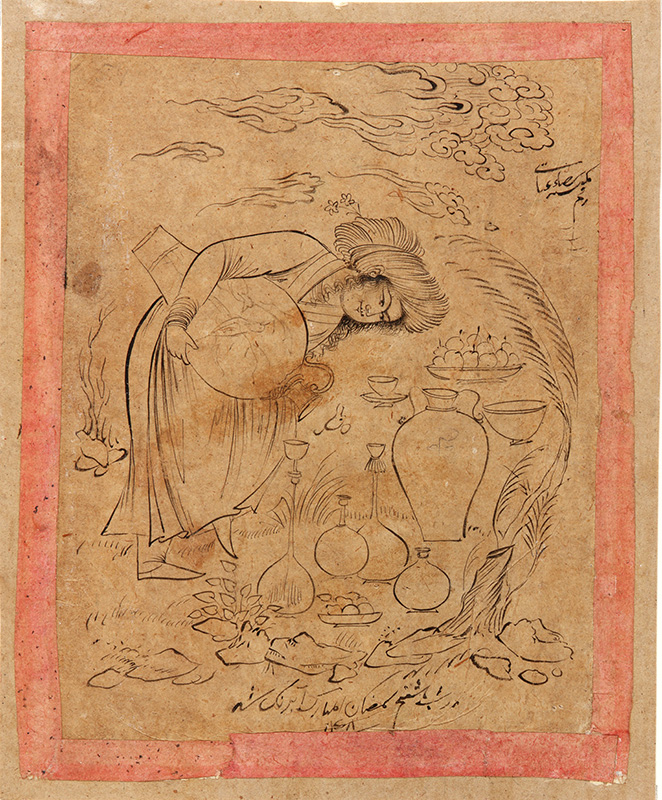Moʿin Moṣavver | Individual Drawings and Paintings
Drawing 1639.1
Cup-bearer Filling Flacons of Wine
Location: Smithsonian Institution, Freer Gallery of Art, no. F1953.28; Purchased Charles Lang Freer Endowment.
Formerly in the Sarre Collection, Berlin.
Pen and ink drawing on paper with color: (H x W) 13.5 x 10.6 cm.
Signature: Fallacious "signature" of Reżā ʿAbbāsi and dated 1[0]48/1639.
Inscription
Top right: raqam-e kamina Reżā ʿAbbāsi. Translation: “ Drawn by the most humble Reżā ʿAbbāsi”.
Bottom: dar šab-e haštom-e ramażān mobārak ābrang šod. sana 1[0]48. Translation: “Watercolored on the evening (preceeding) the eighth of blessed Ramażān in the year 1[0]48 / 13 January 1639.” Although unsigned, this inscription appears to be be in the hand of Moʿin Moṣavver.
Description:
Only one figure is represented, a male cup-bearer, dressed in a long robe, slippers, and a large turban. He bends over, holding a large jug decorated with birds under his arm, in order to pour wine or other drink into a long-necked bottle. Other bottles of various shapes, another large jug, some bowls and platters of fruit are grouped about the ground near his feet. In the foreground is an irregular row of stones with some foliage, on the right the stump of a small tree and some willow branches, and at the top stylized Chinese scroll clouds.
Bibliography:
Sarre-Mittwoch, ZRA, pl.16.
Kühnel, Survey, p.1894 (not ill.).
Stchoukine, SA, pp.63 (not ill.).
Baḵtiyār, RA_1971, pl. p.7.
Commentary:
At the beginning of 1639 Reżā ʿAbbāsi had already been dead for almost four years, so its authenticity is certainy subject to doubt. The second inscription, which gives the date, is written in a jagged style, and could very well be Moʿin’s hand (cf. inscription on no. 1672.1). Although the composition of the drawing may inspired by a work of Reżā, it is drawn with a vigour and hardness in the line that is not his, but rather that of Moʿin. Compare, for example, the facial treatment of the cup-bearer with similar representations in nos. 1638.1, 1638.2, 1642.1, and 1642.2. Altogether, an attribution to Moʿin appears plausible, and there seems to be no reason to dispute the 1639 date recorded on the miniature. As to the Reżā “signature”, this is not an isolated instance -- see commentary to no. 1638.3.
Photo courtesy of The Freer Gallery of Art, Smithsonian Institution, © The Freer Gallery of Art
Robert Eng
Last Updated: March 2, 2018 | Originally published: March 2, 2018
Drawing 1639.1
Cup-bearer Filling Flacons of Wine
Location: Smithsonian Institution, Freer Gallery of Art, no. F1953.28; Purchased Charles Lang Freer Endowment.
Formerly in the Sarre Collection, Berlin.
Pen and ink drawing on paper with color: (H x W) 13.5 x 10.6 cm.
Signature: Fallacious "signature" of Reżā ʿAbbāsi and dated 1[0]48/1639.
Inscription
Top right: raqam-e kamina Reżā ʿAbbāsi. Translation: “ Drawn by the most humble Reżā ʿAbbāsi”.
Bottom: dar šab-e haštom-e ramażān mobārak ābrang šod. sana 1[0]48. Translation: “Watercolored on the evening (preceeding) the eighth of blessed Ramażān in the year 1[0]48 / 13 January 1639.” Although unsigned, this inscription appears to be be in the hand of Moʿin Moṣavver.
Description:
Only one figure is represented, a male cup-bearer, dressed in a long robe, slippers, and a large turban. He bends over, holding a large jug decorated with birds under his arm, in order to pour wine or other drink into a long-necked bottle. Other bottles of various shapes, another large jug, some bowls and platters of fruit are grouped about the ground near his feet. In the foreground is an irregular row of stones with some foliage, on the right the stump of a small tree and some willow branches, and at the top stylized Chinese scroll clouds.
Bibliography:
Sarre-Mittwoch, ZRA, pl.16.
Kühnel, Survey, p.1894 (not ill.).
Stchoukine, SA, pp.63 (not ill.).
Baḵtiyār, RA_1971, pl. p.7.
Commentary:
At the beginning of 1639 Reżā ʿAbbāsi had already been dead for almost four years, so its authenticity is certainy subject to doubt. The second inscription, which gives the date, is written in a jagged style, and could very well be Moʿin’s hand (cf. inscription on no. 1672.1). Although the composition of the drawing may inspired by a work of Reżā, it is drawn with a vigour and hardness in the line that is not his, but rather that of Moʿin. Compare, for example, the facial treatment of the cup-bearer with similar representations in nos. 1638.1, 1638.2, 1642.1, and 1642.2. Altogether, an attribution to Moʿin appears plausible, and there seems to be no reason to dispute the 1639 date recorded on the miniature. As to the Reżā “signature”, this is not an isolated instance -- see commentary to no. 1638.3.
Photo courtesy of The Freer Gallery of Art, Smithsonian Institution, © The Freer Gallery of Art
Robert Eng
Last Updated: March 2, 2018 | Originally published: March 2, 2018
